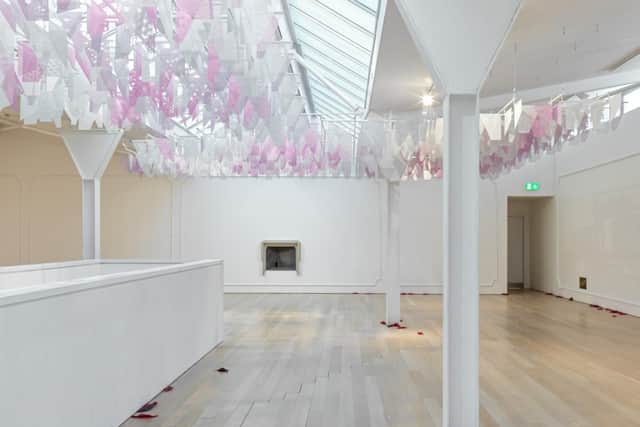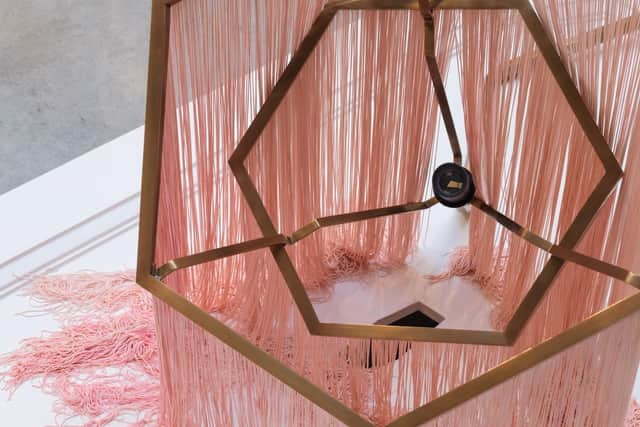Art review: Martin Boyce: Before Behind Between Above Below, Fruitmarket, Edinburgh
Martin Boyce: Before Behind Between Above Below, Fruitmarket Gallery *****
The earliest work in Martin Boyce’s outstanding exhibition at the Fruitmarket is a series of photographs called "Interiors”. Made in 1992, a couple of years after leaving art school, these grainy stills from the film Jagged Edge capture the briefest moments before an actor comes into the frame, or just after they have left. There’s a passage into an empty room, a cupboard door standing slightly ajar, a lamp on a table.
Advertisement
Hide AdThey are so ordinary, one might walk straight past them, but start looking and they seem to be full of suggestion, full of what has happened or might be about to happen. And without being able to say why, we know that whatever’s happening isn’t good.
In the three decades since, Boyce has become a master of quiet suggestion, of conjuring atmosphere, particularly in liminal, unpopulated spaces. This imaginative universe is juxtaposed with a rigorous, formal lexicon of shapes which unifies his work visually across sculptures, wall panels and installations. He has represented Scotland at the Venice Biennale (2009), won the Turner Prize (2011) and become one of Scotland’s most successful artists, with much of that success happening outside Scotland.
This is his biggest show in Scotland for two decades and the first to include a survey element, drawing work from across his career. For the Fruitmarket, which celebrates its 50th birthday this year, he was an obvious choice: he first showed here in 1999 in the Visions for the Future series for early career Scottish artists (he was downstairs, Ross Sinclair was upstairs). For this show, he decided to focus on works never shown in Scotland, though, being honest, that’s hardly a limitation.
Ever with an eye to architecture, Boyce creates distinct atmospheres in each of the three exhibition spaces. Downstairs, wall-based works come together in a space divided by corrugated plastic partitions. As well as the Jagged Edge photographs, there is an early walled-in shelving unit, a door jammed shut with a chair under the handle, two lightless lanterns like those made for in his 2019 outdoor installation at Mount Stuart. Ordinary objects are stripped of their purpose: doors don’t open, lamps don’t light, telephones call no one.
At its most menacing, this is a world from which there is no escape. The phone lines are cut, the door is barricaded and an unnamed evil stalks beyond. Suspense and film noir were early influences, the titles look like addresses: 276 Silent Falls, 129 Fear View Lane, 1056 Endless Heights.


Like much of Boyce’s work, there is an intricate field of references here, drawing on film, music, architecture and design. While all of that is worth discovering, the wonder is that we don’t really need it in order to have an imaginative response. A house blessing is printed over a pattern of cracked glass, immediately evoking the nameless thing against which the blessing is supposed to protect. Ventilation grilles read “before”, “behind”, “between”, “above”, “below”. Are they innocently drawing our attention to the invisible workings of a building, or is it something more? What lies beneath? What indeed.
Advertisement
Hide AdEven as he creates a feast for the fertile imagination, Boyce is not above showing his workings. In this show, for the first time, he has included a collection of drawings and maquettes which demonstrate how he derived his visual lexicon from the concrete trees designed by artist brothers Joël and Jann Martel for the 1925 International Exhibition of Modern Decorative and Industrial Arts in Paris. This modular system of shapes has informed the majority of his works since, and the unique alphabet he uses in his wall panels.
In the upstairs gallery, the mood is very different. In Future Blossom (For Yokeno Residence), made for a show in Toronto in 2022, the pillars in the space become tree trunks holding up a canopy of pink and white. Though in fact made of geometric panels of powder coated steel, this “blossom” looks soft, light-filled, ethereal. A few red leaves of waxed paper scatter about the floor: spring and autumn happening simultaneously.
Advertisement
Hide AdJust when it’s starting to feel like a outdoor space – a conceit he used in Venice, for the Turner Prize and in his seminal early show at Tramway in 2002 – one notices the moulded panelling on the walls and the fireplace at the far end receding into the wall at an angle and ending with a small black rectangle, another door to nowhere. Even when setting the viewer off on an imaginative path, Boyce knows precisely when to wrong-foot and discombobulate.


Also in this space is Dead Star Reclining, a broken standard lamp with a pink, fringed shade. This is one of the most anthropomorphic of all Boyce’s objects, a fallen Hollywood starlet with strawberry blonde hair, destined to play women murdered in film noirs, dead before they have a meaningful part to play in the story.
In the warehouse space, he creates an interior which is part museum-store, part exhibition under construction. His work for Venice, A River in the Trees, is in one corner, the concrete slabs stacked up, the paper leaves in a cardboard box. And this is a master stroke, because it leaves us to create the work, to remember how eerie it felt in the crumbling palazzo, and to add the further layers of resonance our memories eagerly supplies.
Other works are arranged here as if waiting their turn for exhibition in spaces divided by gauzy curtains. Slim metal armatures on plinths look like they might be used to display something else and – if you stare at them for too long – start to look like faces. Piles of stacked chairs look like patio furniture stored for the winter, though they are in outline only, furniture in pencil lines. Fear Meet The Soul, from 2008, is a kind of mobile which balances as if weightless, a reminder that Boyce is first a sculptor, concerned with form, shape, colour, how objects occupy space, before he became a conjurer with imagination and memory.
Memory has always been an important theme in his work. When he built a night-time park in Tramway in 2002, he was recreating the memories of all of us who occupied such spaces as suburban teens. Now that work exists in our memories, as does the ghostly tennis court in Mount Stuart, which slips deeper into memory with each passing year. And these sculptures in this show have memories, from shows in Venice, New York, Zurich. Do they compare whispered notes, one wonders, when the gallery is shut at night?
The show concludes with another group of photographs. Laid out on a blanketed table, as if waiting to be hung in an exhibition, the series known as Spook School were taken on a visit to GSA’s Mackintosh building during the refurbishment after the first fire. They show blackened walls, doors removed from their hinges, damaged plastercasts of the Parthenon marbles.
Advertisement
Hide AdHere is another liminal space, full of memories. But when these photographs were taken, no one could have known that the Mack would be destroyed again, much more completely, in a second devastating fire. Haunting to begin with, they now feel like the last living remnants of a much more terrible loss. Like so many of Boyce’s clever, suggestive works, they leave us space to bring what we bring: our sadness, our anger, our grief.
Until 9 June